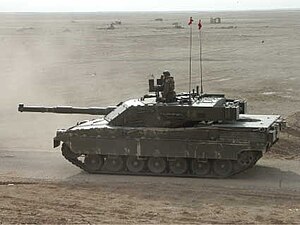| C1 Ariete | |
|---|---|
 Ariete | |
| Type | Main battle tank |
| Place of origin |
|
| Production history | |
| Produced | 1995 - Present |
| Specifications | |
| Mass | 54 tonnes |
| Length | 9.67 m (7.59 without gun) |
| Width | 3.42 m |
| Height | 2.50 m |
| Crew | 4 |
|
| |
| Armor | Classified, steel/composite blend |
Main armament |
120mm 44 calibre smoothbore tank gun 42 rounds (15 rounds inside turret magazine with additional 27 rounds in the chassis) |
Secondary armament |
7.62mm coaxial machine-gun, 7.62mm AA machine-gun 2,500 rounds |
| Engine |
V-12 turbocharged diesel FIAT MTCA 1,247 hp (937 kW) |
| Power/weight | 23 hp/tonne |
| Suspension | torsion-bar |
Operational range | 550 km |
| Maximum speed | 65–70 kilometres per hour (40–43 mph) |
| ||||||||||||||||||||||||||||||||||||||||
The C1 Ariete is the main battle tank of the Italian Army, developed by a consortium formed by Iveco-Fiat and Oto Melara (aka CIO, Consorzio Iveco Oto Melara). The chassis and engine were produced by Iveco, while the turret and fire-control system were produced by Oto Melara. The vehicle carries the latest optical and digital-imaging and fire-control systems, enabling it to fight day and night and to fire on the move. The first deliveries were in 1995, and the last occurred 8 years later in August 2002.
Armament
The Ariete is mounted with a 120 mm smoothbore Oto Melara cannon, autofrettaged and stress-hardened to increase durability over extended periods of fire, allowing the use of APFSDS and (HEAT) rounds.
Secondary armament consists of a 7.62 mm coaxial machine gun and another 7.62 mm anti-aircraft machine gun manned by the tank commander.
Crew and tank protection
The Ariete's armour is a steel and composite blend, similar to the British Challenger 2 tank and the American M1 Abrams.
The Ariete features two side-mounted, electronically-fired grenade launchers. Each launcher consists of four barrels which can be intermixed with either smoke or chaff grenades. The smoke grenades are capable of shrouding the tank from visual or thermal detection, while the chaff grenades disperse the tank's radar cross section. The tank is fully NBC protected.[1]
Fire control and target acquisition
The tank's fire-control system, manufactured by Galileo Avionica, is designated TURMS, and includes day and night panoramic capability for the commander's scope, stabilized gunner's platform including thermal optics and a laser rangefinder to increase accuracy and expedite target detection and targeting, and a digital fire-control mini-computer, which is capable of measuring wind speed, humidity, and exterior weather conditions, combining them with the turret's angle of elevation, attitude, and the barrel's physical wear to increase accuracy.
Powerplant and drivetrain
The Ariete is powered by a 25.8 litres turbo-charged Fiat-Iveco 12-cylinder diesel engine rated at 937 kilowatts (1250HP) at 2.300 rpm, with a max torque of 4.615 Nm at 1.600 rpm[2] driving through a ZF LSG3000 automatic transmission, with four forward gears and two reverse, allowing for a top cruising speed of 65 km/h. The transmission allows it to climb grades rated up to 60%, and can ford waterways of up to 1.25-m on-the-fly.
The caterpillar tracks are fairly standard, composed of seven road wheels and four drive rollers.
Developments

C1 Ariete.
During the first years of adoption, the Ariete MBT showed some deficiencies regarding the powerplant. While the original V12 1,250 hp FIAT-Iveco MTCA (Modular Turbo-Charged Aftercooler) was a coupling of two of the V6 engines used by several Italian Army vehicles such as the Centauro tank destroyer and the Dardo IFV, it produced less power than the most advanced contemporary western designs. The Ariete's engine had to run at a high RPM to perform well, thus reducing the operating time between failures.
Moreover, to retain a good power to weight ratio, the total weight of the tank had to be kept below 60 tonnes. The relatively light weight of the Ariete helped lower consumption and facilitated the transport and mobility of the MBT (especially over bridges). This was obtained partially at the expense of the thickness of the armour that, only partially compensated by the good ballistic shape of the vehicle, raised some doubt about its ability to survive in the harshest environments.
As an improvement, Iveco developed a new version of the MTCA engine. The stroke was lengthened, increasing displacement to 30 litres, with a new common rail direct fuel injection system along a new double turbocharger, increasing power output to 1,600 hp at 1,800 rpm (with an electronically reduced torque of 5,500 Nm, maintained from 1,100 to 1,800 rpm to reduce damage to the transmission) and further reducing fuel consumption. The new engine will be adopted during the first general revision of the existing vehicles. As for the armour, Oto Melara developed two different sets (with different thickness) of adjunctive armour, shown for the first time at Eurosatory 2002.
Operators
 Italy - 200
Italy - 200
- 20° Tank battalion "M.O. Pentimalli", 4° Tank Regiment of Bellinzago Novarese (NO), 41 Ariete
- 3° Tank battalion "M.O. Galas", 32° Tank Regiment of Tauriano (PN), 41 Ariete
- 8° Tank battalion "M.O. Secchiaroli", 132° Tank Regiment of Cordenòns (PN), 41 Ariete
- 31° Tank battalion "M.O. Andreani", 131° Tank Regiment of Persano (SA), 41 Ariete
See also
References
The original article can be found at C-1 Ariete and the edit history here.